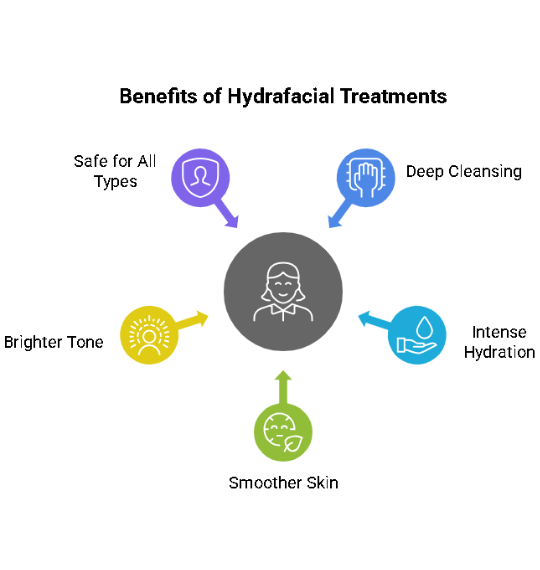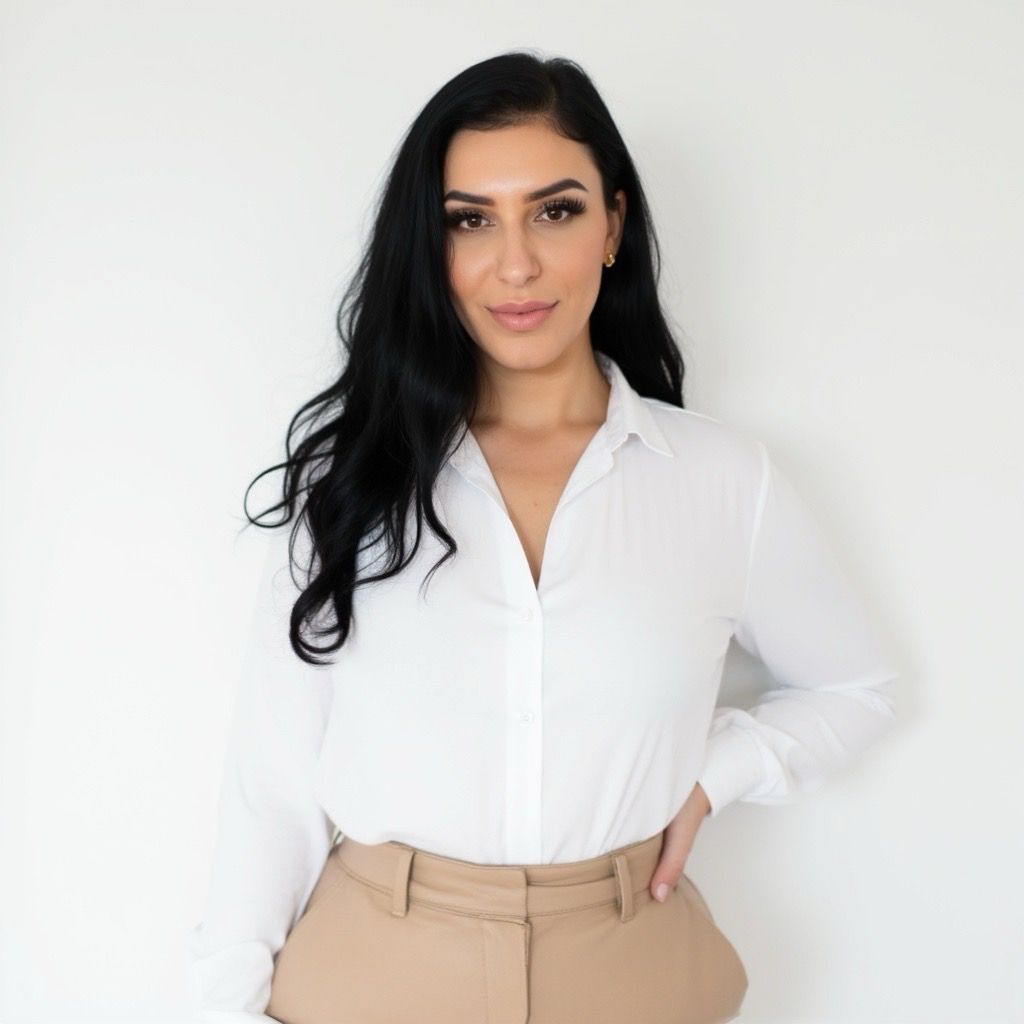If your skin feels dull, clogged, or constantly dry, a hydrafacial can be the best possible solution. Hydrafacial treatments—a gentle yet effective option that cleans, exfoliates, and hydrates in one visit, without any irritation or any kind of side effects. Because it uses a machine-based system that removes buildup while delivering nourishing ingredients deep into your skin, the results are quick: brighter, cleaner, and smoother skin with no redness or downtime.
In contrast, traditional facials often rely on harsh scrubbing or strong chemicals, which can irritate the skin and lead to breakouts, dryness, or rashes, especially for those with sensitive skin.
In this guide, we’ll explain how Hydrafacials work, their benefits, and how they can help improve your skin over time. Let’s start with the basics.
What Is a Hydrafacial and How Does It Work?
A Hydrafacial is a non-invasive skin treatment that deeply cleanses, exfoliates, and hydrates your skin in one session. It uses a specialized device to deliver results quickly, without irritation or downtime.
What makes Hydrafacial different from traditional facials is how it works. Instead of manual extractions or abrasive scrubs, it uses a gentle, machine-powered suction system combined with targeted serums. This allows for a deeper clean and better product absorption, without the redness or discomfort that often follows standard facials.
Step-by-Step Breakdown of the Procedure
1. Cleansing & Exfoliation
The treatment starts by removing dead skin cells and surface debris. This helps open up your pores and smooth out rough texture.
2. Gentle Acid Peel
A mild solution is applied to loosen dirt, oil, and impurities trapped inside the pores. Unlike stronger peels, this step doesn’t sting or cause flaking.
3. Extraction
Using vacuum-powered suction, the device painlessly clears out blackheads, buildup, and excess oil from the pores.
4. Hydration & Serum Infusion
Finally, your skin is infused with hydrating serums packed with antioxidants, peptides, and hyaluronic acid. This leaves your skin feeling soft, plump, and refreshed.
Key Skin Benefits of HydraFacial Treatments

Hydrafacial isn’t just a feel-good treatment—it delivers real results you can see and feel. Here are five key benefits that make it stand out from other facials.
1. Deep Cleansing Without Irritation
Hydrafacial clears out dirt, oil, and dead skin using a gentle suction system. It cleans deeper than most traditional facials without squeezing or scraping the skin. This helps reduce blackheads, whiteheads, and clogged pores without causing redness or discomfort.
2. Intense Hydration That Lasts
Dry, flaky skin can make your face look dull and feel tight. Hydrafacial ends each session with a serum rich in hyaluronic acid and antioxidants that sink deep into the skin. This helps lock in moisture, leaving your face soft, plump, and glowing for days.
3. Smoother Skin and Fewer Fine Lines
By removing buildup and boosting hydration, Hydrafacial helps improve your skin’s texture. It also promotes better cell turnover, which can reduce the appearance of fine lines and make the skin look firmer and more even over time.
4. Brighter, More Even Tone
Uneven skin tone, sunspots, and dullness can all make your skin look tired. Hydrafacial includes brightening agents that help fade dark spots and support a more even, radiant complexion, without using harsh peels or bleaching agents.
5. Safe for All Skin Types
Whether your skin is oily, dry, sensitive, or acne-prone, Hydrafacial can be customized to fit your needs. Since the treatment is gentle and non-invasive, it works well for people with skin concerns that would react badly to harsher products or techniques.
How Often Should You Get a Hydrafacial?
Most people see visible results after just one Hydrafacial, but the real benefits build over time. For best results, a good routine is once a month. This keeps your skin clean, hydrated, and glowing while helping prevent buildup and breakouts.
If you have specific concerns like acne, dullness, or fine lines, your provider might suggest starting with treatments every 2–3 weeks for the first few sessions. Once your skin improves, you can switch to a monthly schedule to maintain the results.
What to Expect After Each Session
Right after your Hydrafacial, your skin will look brighter and feel deeply hydrated. There’s no downtime, so you can go back to your day without worry. Any redness is usually mild and fades within a few hours. Most people notice a smoother texture and a healthy glow right away.
Who Is a Good Candidate for a Hydrafacial?
Hydrafacials are safe for most people and suit a wide range of skin concerns. Here’s a quick breakdown:
Ideal Candidates
- Anyone with dull, dry, or uneven skin tone
- People dealing with clogged pores, blackheads, or breakouts
- Those looking to reduce fine lines or improve texture
- Sensitive skin types that can’t handle harsh treatments
- Anyone prepping for an event who wants an instant glow
Who Should Avoid It (For Now)
- Pregnant individuals (some ingredients aren’t tested for pregnancy)
- People with active rashes, sunburn, or rosacea flare-ups
- Anyone who’s recently had certain skin procedures (check with your provider)
- Those with allergies to any active ingredients used in the treatment
Always consult a certified provider before booking to make sure it’s a good fit for your skin.
Hydrafacial vs. Other Facial Treatments
Hydrafacial stands out because it offers consistent results with minimal irritation. Here’s how it compares to other popular facial treatments:
Traditional Facial vs. Hydrafacial
- Hydrafacial: Uses a machine to cleanse, exfoliate, and hydrate with zero manual squeezing or harsh scrubs.
- Traditional Facials: Often rely on manual extractions and abrasive products that can leave skin red or irritated—especially for sensitive types.
Chemical Peels vs. Hydrafacial
- Hydrafacial: Gently removes dead skin and dirt using mild acids and suction. No flaking or downtime.
- Chemical Peels: Use strong acids to resurface the skin. Results vary and often come with peeling, redness, and recovery time.
Microdermabrasion vs. Hydrafacial
- Hydrafacial: Suits all skin types, including sensitive or acne-prone skin. Adds hydration while cleansing.
- Microdermabrasion: Uses crystals or a wand to sand the skin. Can feel rough and may cause dryness or irritation for some.
In short, a Hydrafacial is a low-risk, all-in-one option for regular skin maintenance. It combines deep cleansing with hydration, something other treatments often skip.
Choosing a Professional Hydrafacial Provider
Getting the best results from your Hydrafacial depends on who performs it. A trained provider like Hajrie knows how to adjust the treatment based on your skin’s needs and can avoid common mistakes.
What to Look For
- Licensed professionals: Choose a certified aesthetician, nurse, or medical provider trained in Hydrafacial.
- Clean and reputable clinic: Make sure the place follows proper hygiene practices and uses genuine Hydrafacial equipment.
- Custom treatment options: Ask if they offer boosters or add-ons that match your skin goals (e.g., brightening, anti-aging, acne care).
- Good reviews and clear communication: Look for honest feedback from real clients and a provider who takes time to explain the process.
Smart Questions to Ask Before Booking
- What’s included in the session—any add-ons or just the basics?
- Are you using the official Hydrafacial machine?
- How do you customize the treatment based on different skin types?
- What should I do before and after the session for the best results?
Choosing the right provider makes a noticeable difference in both comfort and results.
Tips to Maximize and Maintain Your Results
A Hydrafacial gives immediate results, but what you do after the treatment helps keep your skin looking its best. Here’s how to make those results last:
Aftercare Tips
- Keep your skin hydrated: Use a gentle moisturizer and drink plenty of water. Hydrated skin stays plump and clear longer.
- Use sunscreen daily: Your skin may be more sensitive to sun after treatment. Apply SPF 30 or higher, even on cloudy days.
- Avoid harsh products for 1–2 days: Skip retinol, exfoliants, and alcohol-based toners while your skin settles.
- Skip heavy makeup for 24 hours: Let your skin breathe and absorb the treatment benefits fully.
Healthy Habits That Support Long-Term Results
- Stick to a simple skincare routine: Cleanse, moisturize, and protect. Don’t overload your skin with too many products.
- Stay consistent: Monthly Hydrafacials combined with daily care will improve your skin over time.
- Eat well and stay hydrated: What you put in your body shows on your skin. Focus on water, fruits, and whole foods.
- Limit stress and sleep well: Stress and poor sleep affect skin health. Aim for 7–8 hours a night and take breaks during busy days.
Conclusion
Clear, healthy skin doesn’t have to come with trial and error or downtime. Hydrafacial is a reliable way to care for your skin that actually works. It’s quick, noninvasive, and flexible enough to fit into any skincare routine, whether you’re just starting or refining what already works.
But the real value lies in consistency. One session can refresh your skin, but regular treatments paired with smart habits can completely change how your skin looks and feels. The glow lasts when you treat your skin like it deserves attention, not just fixes.
Ready to experience the difference for yourself? Book your Hydrafacial at The Aesthetics Loft in Milford, CT, and let our expert provider, Hajrie Sulejman,I help you reach your skin goals—comfortably and confidently.

